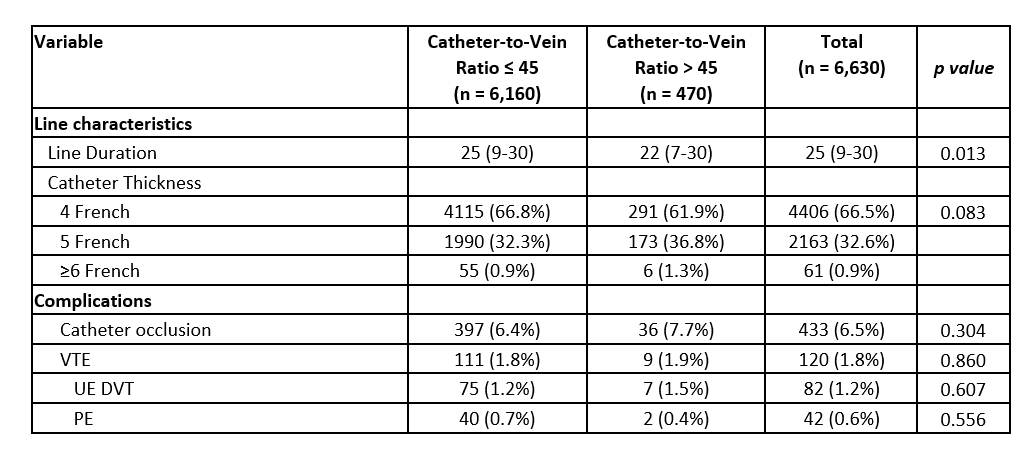Background: We evaluated whether a catheter-to-vein ratio (CVR) of >45% increases the risk of venous thromboembolism [VTE] and catheter occlusion associated with peripherally inserted central catheters (PICCs).
Methods: From August 2020 to April 2022, trained abstractors collected demographic and clinical data on patients receiving PICCs while admitted at 52 hospitals participating in the Michigan Hospital Medicine Safety Consortium. Patients were followed until PICC removal, death, or 30 days following placement, whichever came first. Primary outcomes included image confirmed symptomatic VTE (including upper extremity deep venous thrombosis and pulmonary embolism) and catheter occlusion. PICC placements with CVR >45% were compared to those with CVR ≤45%. The association between CVR >45% and primary outcomes was also assessed after PICC placements were stratified according to catheter thickness. Comparisons used Chi-square tests for categorical variables and t-tests and Wilcoxon rank-sum tests for continuous variables.
Results: A total of 6,630 PICCs with documented CVR and catheter size were included in the analysis. Of these, 470 (7.1%) had CVR >45% and 6,160 (92.9%) had CVR ≤45%. The PICC catheter sizes were mostly 4-French (66.5%; N=4,406) and 5-French (32.6%; N=2,163); and median dwell time was 25 days (interquartile range, 9 to 30 days). Overall, catheter occlusion occurred in 433 (6.5%) PICCs and VTE in 120 (1.8%). PICCs with CVR>45% had similar rates of complications when compared to CVR ≤45%: catheter occlusion, 7.7% vs 6.4% (p=0.304); and VTE, 1.9% vs 1.8% (p=0.860). When stratified by catheter thickness, the rates of both complications were also similar between both groups. Overall, 5-French compared to 4-French catheters had higher rates of catheter occlusion, 11.0% vs 4.2% (p<.001) and VTE, 3.1% vs 1.2% (p<.001).
Conclusions: In our analysis, CVR of >45% was not associated with PICC-related VTE or catheter occlusion. However, increasing catheter thickness was associated with a higher risk of VTE and catheter occlusion. Further studies are needed to identify the optimal catheter-to-vein ratio to predict PICC-related complications, and to assess the effect of catheter thickness on such association.


